Abstract
This study aims to clarify a new endogenous model of geocultural villages by examining land use change, industrial transformation, and their impacts on rural society and the economy of Baiyankeng village, Zhejiang Province, China. This empirical study focuses on the actions of residents and their effects after Baiyankeng was registered as the pilot geocultural village in China. To address the dual configuration of urban/rural areas and three-dimensional rural issues, the Chinese government released a set of policies for rural vitalization in the early 2000s, which included the establishment and promotion of geocultural villages in 2013. This study found that the local leadership—the township government and the village committee—played a significant role in leveraging the unique geological resources of the village. They aggressively pitched for Baiyankeng village to be recognized as the first-ever geocultural village, and successfully established an effective model of self-governance that empowered villagers to actively and enthusiastically participate in the process. By doing so, they successfully created a booming tourism industry while boosting local production of Chinese Torreya nuts and green tea. From the perspective of the land system in China, the mechanism of geocultural villages (henceforth known as rural geoparks) in this study shows new endogeneities of rural vitalization in China.
1. Introduction
1.1. Background of the Study
“Three-dimensional” rural issues concerning the state of agriculture, the countryside, and farmers are long-standing problems in Chinese society [1,2,3,4]. One significant reason for these problems is the urban and rural household registration system in China. Residents living in urban and rural areas of China are registered differently, which means that they are covered differently by the social welfare system. Urban residents generally received greater coverage in medical and social insurance as compared to rural residents before the promulgation of the Reform and Opening Up policies in 1978. The dual configuration of urban/rural areas and the lack of innovation in traditional agriculture thus resulted in a lack of endogenous driving forces for the development in rural China [5,6,7]. After the Reform and Opening Up policies were adopted, the industrialization of rural areas, fortunately, solved the development bottleneck in these areas to a certain extent [8]. Meanwhile, the rapid globalization, industrialization, and urbanization of China helped the country to greatly surpass the rest of the world in terms of economic growth since the 1990s. This, however, led labor, capital, and land to start flowing out of rural areas, which exacerbated these issues and further discouraged endogenous development [9]. The emergent three-dimensional rural issues included the exclusion of agriculture, the hollowing out of the countryside, and the aging of farmers in contemporary China [10]. In other words, the disparity between urban and rural areas, as well as the lack of endogenous driving forces, have caused rural areas of China to develop at a slower pace as compared to its urban areas. This has led to growing calls to promote the integrated development of urban and rural areas, which led to a set of government policies charting a roadmap for rural vitalization.
The term “endogenous development” was first used by the Dag Hammarskjöld Foundation, in What Now? Another Development that was published in 1975 on the occasion of the 7th Special Session of the United Nations General Assembly [11]. The new concept of “another development” was mentioned at that time, which led to the coinage of the term “endogenous development”—a concept that connects the collective and individual realms and aims to foster self-reliance at local, national, and international levels [12]. Marc Nerfin used the term “the third system” to describe endogenous development as a kind of social movement representing the people and their associations, in contrast to the development representing the government (first system) and economic powers (second system) [13,14]. This concept was further refined by Kazuko Tsurumi and Kenichi Miyamoto; their definitions of endogenous development are shown in Table 1. While they both acknowledged the importance of connecting with outsiders, their definitions differed from one another from the perspective of social movements and policies [15,16,17]. Tsurumi [14] emphasized the importance of social interaction between permanent residents and outsiders for endogenous development (pp. 23–29). She particularly stressed the need to raise the awareness of local residents about the importance of learning and interacting with outsiders to drive new development [17]. In contrast, Miyamoto [18] (pp. 295–298) argued that depopulated municipalities should rely more on government subsidies in light of the actual development situation [17]. To summarize, endogenous development represents multiple values rather than a single value concerning the varieties of religion, history, culture, and regional ecology [15].

Table 1.
Differences between perspectives of Tsurumi [14] and Miyamoto [18] on endogenous development.
Geotourism can help realize multiple values of endogenous development. Thomas A. Hose defined geotourism as “niche tourism” [19] or “special interest tourism” [20]. Originally, “geotourism” was meant to promote and fund the preservation and conservation of geosites and geomorphosites [21] and to recognize and promote their regional, national, and international geoscientific significance [20]. Burek et al. [22] defined geoconservation as “action taken” with the intent of conserving and enhancing geological and geomorphological features, processes, sites, and specimens, which can inform an enlightened public and contribute to the environmental, social, and economic pillars of sustainable development [23].
A geopark is one way to realize geotourism. Currently, UNESCO Global Geoparks are defined as single, unified geographical areas where sites and landscapes of international geological significance are managed and governed by a holistic concept of protection, education, and sustainable development. Their bottom-up approach of combining conservation with sustainable development while involving local communities is becoming increasingly popular [24]. UNESCO’s work with geoparks began in 2001, and the Global Geoparks Network (GGN) was formed shortly after in 2004 [24]. China is one of the few countries to have established and recognized geoparks before UNESCO did, rooted in its awareness of geoconservation dating back to the 1950s [25]. In the middle of the 1980s, several years after the Reform and Opening Up policies, the Ministry of Land and Resources of China started the development work of the so-called national geoparks. The instruction for national geoparks published in 1985 guided the establishment of future geoparks in China [26]. Given this special background, geoparks in China were constructed differently compared with their global counterparts, which drove the development of the former’s unique features.
1.2. Problem Statements
Geoparks in China are administrated by national or provincial governments, with a top-down approach. On the one hand, this guarantees the quality of management. On the other hand, this has resulted in low awareness of geoparks and a lack of participation in geopark-related activities among local residents. Many scholars have examined both the advantages and disadvantages underlying geoparks in China. For instance, Han et al. [27] claimed that geoparks create a win–win situation in which the locals can both enjoy economic growth and take increased pride in their hometowns. Conversely, Dong et al. [25] claimed that geoparks in China are fraught with problems such as inadequate geoconservation measures at geosites, a conflict between ecological restoration and scientific observation, ineffective interpretation of geological features for visitors, the lack of an engaging way to exhibit the materials in museums, and insufficient financial support. Wang et al. [28] argued that there was a lack of legislative clarity regarding permitted access to geosites in China. They also noticed that community residents have not participated in geoconservation training and, as such, have limited knowledge of geosites. In other words, there is a gap between managers and local communities. However, most Chinese scholars were looking at the problems from a micro, inside perspective, and not a macro, outside perspective. Few previous studies have approached this issue from the perspective of an exogenous, top-down administration system and land ownership system in China. Yet, among the overseas studies of geoparks in China, Fukami [29] conducted fieldwork at the Funiushan UNESCO Global Geoparks in 2012 and found that the top-down administration in China designed geoparks to resemble large theme parks, with little variation in management. Their goal was to develop the regional economy by promoting geotourism [26]. Fukami [26] also pointed out that since geoparks in China are always administrated and operated by national or provincial governments, the activity and participation of local residents are practically nonexistent, which deviates from the original purpose of geoparks.
The underlying reasons for the top-down administration of geoparks can be traced back to the socialistic characteristics of the land system in China. Authoritative control of land use necessitates strong cooperation with the government in the operation and administration of geoparks. According to the Land Law of China [30], the land system is characterized by socialist public ownership. Land in rural and suburban areas (except for that legally owned by the country) is collectively owned by registered rural residents. While the individual transfer of land ownership in China is prohibited, the country may requisition collectively owned land in the name of public interest in lieu of fair compensation to the registered owners. Land may also be assigned to institutions and individuals for use in accordance with the law, the rights to which are transferrable. The government controls land use and strictly protects cultivated land, especially those permanently designated as prime cropland conservation areas. Additionally, China simultaneously abolished the collection of agricultural taxes in January 2006 and implemented a subsidy policy for agriculture and grain growing, with the subsidy amount being linked to the size of the contracted agricultural land area [31].
However, compensation may also cause problems. Chang et al. [32] conducted a questionnaire survey of the local residents in Qinling Zhongnanshan UNESCO Global Geopark and found that among the 50 respondents who had their farmland requisitioned for the geopark’s establishment, not all of them received financial compensation. Compensation was also not equally distributed among those who did receive it. Chang et al. [32] argued that the failure to implement a reasonable compensation scheme might be due to the complexity of the top-down management system, which results in a lack of negotiations and agreements between different government agencies. Fukami [26] described similar problems of lack of negotiations and agreements in the so-called “vertically segmented administration” as most geoparks in China simultaneously belong to national nature reserves and national forest parks, where economic activities are often restricted. Chang et al. [32] ultimately believed that the local residents were not very interested in geoparks and were dissatisfied with the compensation they received because the government did not provide enough geopark-related job opportunities to them.
1.3. Objectives of the Study
Based on the current situation of geoparks and the promotion policies of rural vitalization, the government of Zhejiang Province proposed the geocultural village strategy in 2013 after accounting for the lack of cultivated land in the province.
The China Geological Survey (CGS) considers a geocultural village to be a village that is both suitable for living and doing business based solely on the endowment of geological resources in the area. By exploring the cultural values of geological science and integrating them with the economy of rural areas, geocultural villages aim to develop characteristic industries and economies that can improve the quality of rural life and their cultural connotations [33].
In this study, a geocultural village is defined as a model of rural vitalization via the promotion of geotourism and is considered a model of endogenous development. Accordingly, this research aims to clarify the new endogenous model of geocultural villages by examining land use change and industrial formation and their impacts on the rural society and economy of Baiyankeng village, the pilot geocultural village in China since 2013. Although many previous studies have noted a lack of participation of local communities in the establishment of Chinese geoparks, few have analyzed this issue from the perspective of the land rights systems in China, and this study aims to address this gap in the literature. Specifically, the endogeneity found in geocultural villages due to the specific administrative system of collective-owned village land is examined closely in this study.
2. Study Area, Materials, and Methods
2.1. Target Area and Its Geological Characteristics
Baiyankeng village is a traditional rural settlement located in the Kuaijishan Mountains of middle Zhejiang, China. It is about 28 km away from downtown Shengzhou City (a county-level city) and about 150 km away from Hangzhou, the provincial capital (Figure 1). By 2019, 251 families were living in this village, with a registered population of 760 [34].
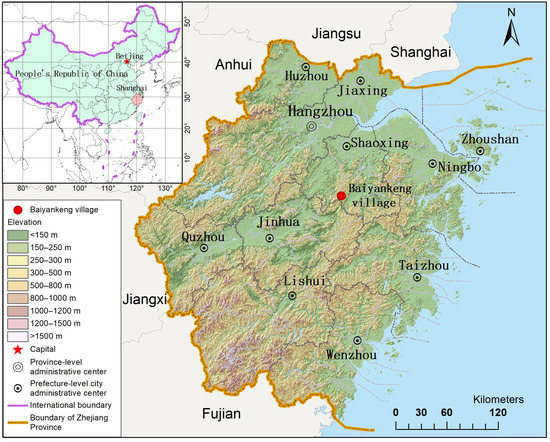
Figure 1.
The location of Baiyankeng village in Zhejiang Province, China (30 m DEM database from the Geospatial Data Cloud, 2019, https://www.gscloud.cn/home, accessed on 1 May 2021).
Baiyankeng village is situated low in the mountains on hilly landforms at an altitude of 500–1000 m, as shown in Figure 2. The slope of the mountain terrain shifts between around 5° and 35°, and the top of the mountain is round and gentle, where alpine wetlands are formed naturally; due to the rise of the crust, the stream erodes and cuts down to form a V-shaped canyon terrain. Mountain streams converge into a larger stream at the bottom of the valley, flowing out of the village from the southwest to the northeast [35]. The villagers are mainly located on both sides of the stream. Baiyankeng village experiences a subtropical monsoon climate with four distinct seasons. During 1960–2013, the annual average temperature was 16.7 °C, and the average annual precipitation was 1304.0 mm [35]. The agricultural climate conditions are advantageous, and it is also an ideal place for people to escape the summer heat.
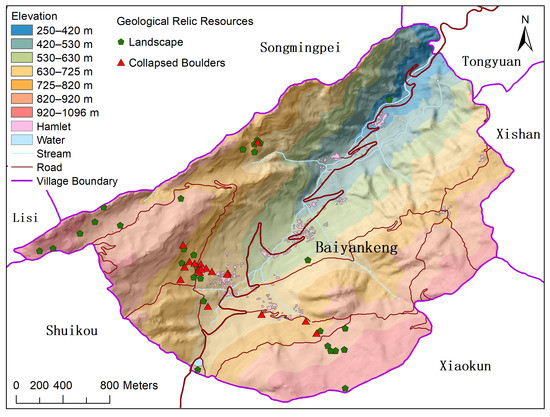
Figure 2.
The DEM (5 m, 2013) and the distribution of geological relics in Baiyankeng village (the DEM and attribute database of the village were collected from the former Bureau of Surveying, Mapping and Geographic Information of Zhejiang Province, and the point data of the distribution of geological relics were obtained from Ref. [35]).
The geological stratum of Baiyankeng village was formed in the early Cretaceous Period and consists mostly of tuff and rhyolite [35]. It is a unique landform with a volcanic rock landscape made up of collapsed boulders, alpine wetlands, canyons, waterfalls, and other geological relic resources, which are all valuable for geotourism (Figure 2). The acidic pyroclastic rocks in Baiyankeng village are weathered into red soil with a deep soil layer (around 0.9–1.9 m thick) and are rich in beneficial trace elements such as zinc, selenium, and iron [35]. This provides an excellent environment for the growth of agricultural products such as Chinese Torreya1 (Figure 3), green tea, and bamboo shoots. The soil also has a low content of harmful heavy metals, easily meeting the national safety standard.
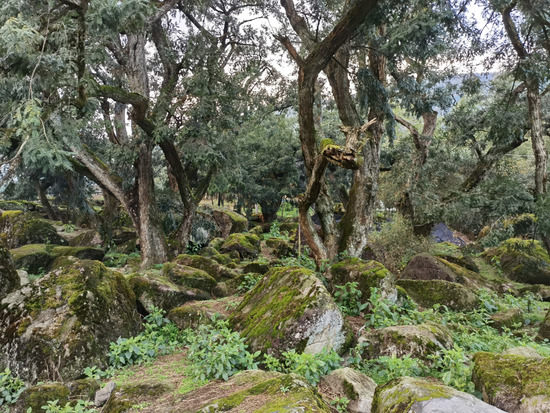
Figure 3.
The landscape consisting of collapsed boulders and Chinese Torreya trees in Baiyankeng village (photographed by a village helper in November 2021).
This stratum created the unique Torreya culture in this village, where most of the villagers grow Chinese Torreya and green tea for a living. The Kuaijishan Mountains are one of the main production areas of Chinese Torreya in China. We can tell from the weathering of Cretaceous volcanic rock strata that Chinese Torreya trees have been cultivated for long periods using ancient grafting and artificial selection techniques [37]. Since the Household Contract Responsibility System with Remuneration Linked to Output2 was implemented in Baiyankeng village in 1983, the villagers have gained the management autonomy of agricultural production that allowed them to do business freely. They gradually developed new hand-pollination techniques in the 1990s [39]. Over thousands of years of human activities, Chinese Torreya trees were grown from among the collapsed boulders, and hamlets were developed among the Torreya trees. A landscape consisting of collapsed boulders, Torreya trees, and hamlets is typical in Baiyankeng village, as evident in Figure 3 and Figure 4. The geocultural village project commenced in this region after the Kuaijishan Ancient Chinese Torreya Community was registered as a Globally Important Agricultural Heritage System (GIAHS) in 2013.
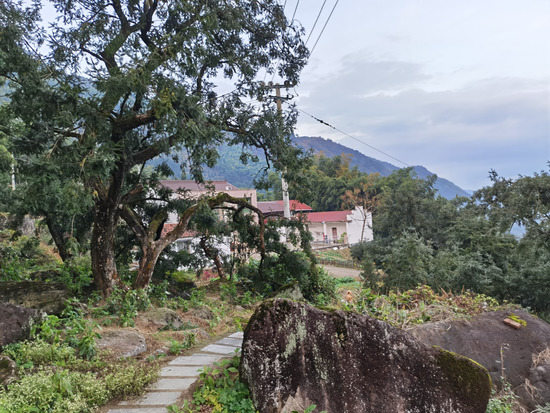
Figure 4.
The landscape consisting of Chinese Torreya trees and hamlets in Baiyankeng village (photographed by a village helper in November 2021).
2.2. Materials and Methods
First, this paper illustrates the transformation of improvement work, land use, the population, employment, and the socioeconomic situation in Baiyankeng village from 2013 to 2019 after the establishment of the geocultural village commenced from the perspective of people’s governance and actions. Second, focusing on the relationship between village transformation and people’s actions, this study explores the reasons behind the transformation. The discussion section of this study will further clarify the endogenous mechanism of geocultural villages and analyze the endogeneity in the specific administrative environment of China’s land systems.
The survey of endogenous development usually focuses on smaller regions [14] (pp. 67–87). For example, Chinese sociologist Fei Xiaotong analyzed and schematized how the differences in traditional social structures led to the formation of specific economic development paths in each region [14] (pp. 67–87). Tsurumi [14] argued that it is mainly the local people who discover in local traditions the keys to solving difficult problems facing humanity today, rebuild old traditions in light of the new environment and, thus, open up diverse paths of development (pp. 29–30). Tsurumi [14] called these people “key persons” (pp. 29–30). Therefore, the present authors conducted the fieldwork to explore the actions of the local people within the scale of an administrative village.
The main data in this study were collected from the village committee and villagers, while other data were obtained from reports and statistical yearbooks of the local government. The data pertained to the background of local rural development, geological survey reports of Baiyankeng village, the policy and planning of the geocultural village, village-scale socioeconomic data, the village chronicle, the funding and improvement process, and villagers’ businesses of running homestay guesthouses and byproduct- processing factories. A total of 17 people, including two people from the local government and 15 villagers, provided data during 2019–2021 through fieldwork and online. All interviewees were over 18 years old and provided verbal consent to participate in the study. The purpose and objective of the study were explained clearly, and the villagers were told that their participation would be voluntary. We collected common knowledge rather than individual ideas or personal information. The basic attributes of interviewees are listed in Table 2.

Table 2.
The basic attributes of interviewees.
The purpose of data collection is to understand the objective transformation of the village since the implementation of the geocultural village policy and how people contributed to this transformation. Besides the collection of village-scale socioeconomic data, which were also collected by the municipal government for the county-scale statistical yearbook, semistructured interviews were conducted to gather common knowledge and ideas on villagers’ contributions and their businesses. The selection of interviewees was mainly based on the principles of comprehensiveness, representativeness, typicality, and randomness. First, the respondents covered both sides—the local government and villagers. The villager respondents were doing not only agriculture but also businesses ranging from homestay guesthouses to agricultural byproduct processing factories. Second, the respondents were representative of various groups of people. The two respondents representing the local government were relevant personnel who directly participated in the management of the geocultural village’s improvement. The former and current members of the village committee had a better understanding of the history and evolution of the village than ordinary villagers. Third, people who had opened homestay guesthouses and byproduct processing factories for longer periods were chosen as they were more typically to have more experience. Finally, other owners of homestay guesthouses and processing factories were randomly chosen.
The interviews were semistructured and contained several open-ended questions. First, for interviews with the respondents from the local government, questions focused on the background of policies, funding and project support, rural development planning, problems in rural development, the management of villages, and contact between the government and the village committee. Meanwhile, documents of rural land use and development planning, survey reports of geological resources for the planned geocultural village, summary reports of improvement planning in the geocultural village, lists of homestay guesthouse applications, and other materials were collected. Second, for interviews with the village committee, the questions focused on the village’s history, development process, resources and conservation, financial status, management system, fundraising and usage, homestay guesthouses, Chinese Torreya and green tea industries, existing problems, and so on. The written form of village-scale socioeconomic data such as land use, population and employment, and revenues, as well as a 17th-century to 21st-century village chronicle written by villagers in 2016, were collected from the village committee and became the firsthand data, which will be discussed in Section 3. Third, for interviews with professional farmers, returnees, and other villagers, the questions focused on the business conditions of homestay guesthouses, employment conditions, types of tourists, and processing and sales of Chinese Torreya nuts and green tea.
As a methodology of analysis, this study classified and sorted both the collected data on people’s actions and socioeconomic data into a chronicled timeline. By concurrently analyzing these two types of data, we can see how people’s actions influenced objective changes. With this, the reasons for the change in land use and socioeconomic data can be clarified.
3. Results
This section summarizes the data collected from Baiyankeng village (2013–2019) through fieldwork and interviews. The results elaborate on the local people’s actions, the change in land use and socioeconomic situation, as well as the reasons for these changes.
3.1. People’s Actions in Baiyankeng Village
3.1.1. Objectives of Development and the Local Government’s Actions
From the perspective of inheriting cultural heritage, the Baiyankeng geocultural village managed to combine various landscape resources and integrate geoculture, Chinese Torreya cultivation culture, and local customs into the development concept [40], which prioritizes scientific and reasonable land use planning and improvement work. The improvement work aimed to transform rural tourism into geotourism, which realizes scientific popularization through leisure activities.
After Zhejiang Province proposed the idea of a geocultural village in 2013, the local Tongyuan Township Government and the Baiyankeng Village Committee took the initiative to negotiate with the provincial and municipal government to make Baiyankeng village the pilot geocultural village. They also actively applied for subsidies from the provincial government as well as raised funds from the township and the village. As shown in Figure 5, the county and township governments raised 31.9 million yuan between 2013 and 2019. Additionally, the village self-raised 3.05 million yuan. The county-level government also encouraged villagers to open homestay guesthouses in their own homesteads by supplying RMB 2500 subsidies for each new room from 2013 to 2019 (Table 3). In other words, the local government was the major investor in the geocultural village project.

Figure 5.
Funds from each administration level of Baiyankeng village (2013–2019) (data provided by the village committee).

Table 3.
The improvement work of Baiyankeng geocultural village.
Accordingly, the public service facilities for geotourism and the infrastructure of the village began to be renovated in 2012. The actions and performance of both governments and local villagers are listed in Table 3. Specifically, a travel trail of 8200 m with display boards of geospot instructions, an open science exhibition plaza covering an area of over three hectares, six science corridors, and two observation decks were constructed. A total of 35 display boards with instructions were set. Parts of the village committee building were utilized as a geocultural exhibition hall. A guidebook for geoscience popularization was compiled, a promotion video called “Living on the Clouds” was filmed, and five traveling routes for geoscience education were recommended in the guidebook [41]. Furthermore, promotional activities such as World Earth Day [42], the Chinese Torreya Festival, and the Chinese Tea Festival were held, further promoting local agriculture and geoculture among villagers and tourists.
As summarized in Table 3, for the improvement of infrastructure, village roads were expanded and repaired, while the greening and gardening work were further improved. Three parking lots and numerous public toilets were constructed for tourists [35,41]. The house facades along the streets were renovated into a more uniform and harmonious manner. Domestic sewage treatment and garbage disposal systems were also improved. As a result, the rural environment and the level of livability were significantly improved.
3.1.2. Local Residents’ Actions
Organized by the village committee, the villagers positively participated in the improvement work of the village. Almost every family supplied labor and contributed funds. For example, the villagers carried the stone materials for the walking trails to the mountains by themselves. However, the participation of villagers did not end here.
Capitalizing on these new opportunities, the villagers used their skills to develop tourism and agricultural product processing industries according to local geographical conditions, seeking their own ways to become rich and promote the formation of the village’s industrial structure. Local residents’ actions and their performance are summarized in the timeline in Table 3.
The biggest change in the village was the development of a green tea and Chinese Torreya processing industry. Most villagers in Baiyankeng village make their living in agriculture using traditional and manual approaches due to the restrictions of the mountainous terrain. Green tea and Chinese Torreya are traditional agricultural cash crops and also the main sources of income for Baiyankeng villagers. Based on the public ownership of the land system of China, each household is distributed one hectare of green tea garden and Chinese Torreya forest. There is almost no transfer of land tenure in the village, and only a few villagers are borrowing land to grow Chinese Torreya from villagers who have left the village all year round. According to the interviews, the annual output of green tea products by the whole village was about 150,000 kg in 2020, with an average of about 600 kg per household. Among the households, more than 20 large households had an annual output of more than 5000 kg. Before 2012, there was only one village-collective and one individual tea processing factory in the village. By 2019, there were five individual tea processing factories in the village (Table 3), among which the original village-collective tea factory was also contracted out to individuals. The production efficiency was largely improved with reduced costs.
Simultaneously, the production of Chinese Torreya nuts also improved. By 2016, the annual output of Chinese Torreya in Baiyankeng village was over 250,000 kg [39], indicating more than 1000 kg per household on average. Before 2012, villagers manually processed Chinese Torreya nuts by hand. After the establishment of the geocultural village, centralized mechanical processing factories for Chinese Torreya nuts were built, which led to greater efficiency. By 2019, there were five individual factories for Chinese Torreya nut processing in the village (Table 3).
The geocultural village also directly promoted geotourism in the village. Some villagers seized the opportunity to convert their spare rooms into homestays and restaurants. Notably, in rural China, the area for a homestead is allocated for each household, and construction land cannot be expanded without authorization, so farmers usually transform the spare rooms in their own houses into homestays. Figure 6 shows the change in the number of guesthouses and caterers in Baiyankeng village from 2013 to 2019. At the end of 2012, two homestay guesthouses were opened as a precedent for Baiyankeng’s homestay and catering industry. In 2019, the number of guesthouses and caterers in Baiyankeng village reached 19, with 276 beds (Figure 6). As mentioned above, newly opened homestay guesthouses were eligible for subsidies from the local government, which was received very positively. Some of the villagers also expanded the scale of their homestay guesthouses by leasing spare rooms from neighbors.
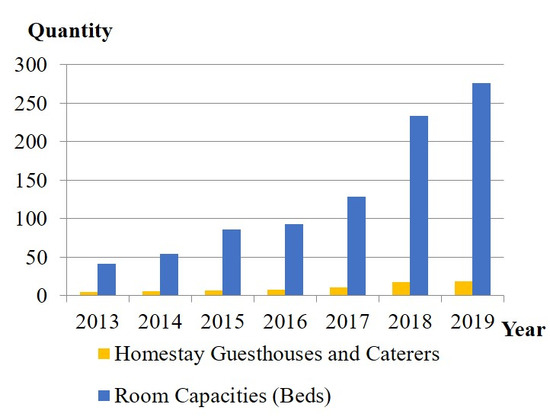
Figure 6.
The change in homestay guesthouses and caterers in Baiyankeng village (2013–2019) (data provided by the village committee).
3.1.3. Self-Governance in Township and Village
The Baiyankeng Village Committee (the self-governing organization comprising villagers) regulates the management of Baiyankeng village by formulating village-level systems under the premise of implementing the policies and systems of the provincial government. As shown in Table 3, The village-level systems include rules to regulate villagers’ behavioral norms, safeguard public interests, protect traditional culture, advocate courtesy and good customs, and protect the ecological environment of the village. Ancient Chinese Torreya trees in the village are strictly protected, and behaviors such as felling and quarrying are strictly prohibited.
The leadership of the township government and village committee was important. After the idea of a geocultural village was conceived in the provincial government of Zhejiang, the Tongyuan Township Government and the Baiyankeng Village Committee were aggressive. They followed the national policies for rural vitalization to formulate land use and rural development plans that were in line with the actual rural conditions, and they actively collected funds to obtain the technical support needed to improve the infrastructure of the village. They were committed to the improvement of agricultural technologies in the village, such as Chinese Torreya cultivation, artificial pollination, and the roasting of both Chinese Torreya and green tea. They encouraged villagers to centralize the roasting of Torreya and tea to lower costs, increase efficiency, and improve product quality. They also encouraged mutual assistance and cooperation among villagers to create new sale channels and platforms for agricultural byproducts and extend the industrial chain. In addition, the Tongyuan Township Government introduced a homestay subsidy policy to develop the tourism industry, which would indirectly drive the production and sales of agricultural byproducts. Festivals and traditional opera performances related to tea and Torreya were held in the village for the publicity of Baiyankeng village.
3.2. Change in Land Use and Socioeconomic Situation of Baiyankeng Village
The geocultural village policy caused many changes in the village from 2013 to 2019. The development of geotourism, homestay businesses, and Chinese Torreya production distinctly improved the economic condition of the village.
3.2.1. Land Use Change
Baiyankeng is a typical village in Zhejiang Province, with scarce cultivated land. Figure 7 shows the land use of Baiyankeng village in 2018. During the period of the planned economy in China, the main production crop of Baiyankeng village was maize and sweet potato, which were not sufficient for subsistence. There were over 2000 old Chinese Torreya trees in the village at that time. After the Household Contract Responsibility System with Remuneration Linked to Output was established in 1983, each villager was given one hectare of land to begin the cultivation of green tea and Chinese Torreya to overcome poverty. After the promulgation of the geocultural village policy, the businesses of homestay guesthouses and caterers, as well as the sales of agricultural byproducts, improved with the resulting development of geotourism. By 2019, the total area of the village was 6.03 km2, 23.2% and 26.3% of which were covered by Chinese Torreya forests and green tea plantations, respectively. Other forests occupied 31.55% of the area, and only 4.5% was cultivated land [34].
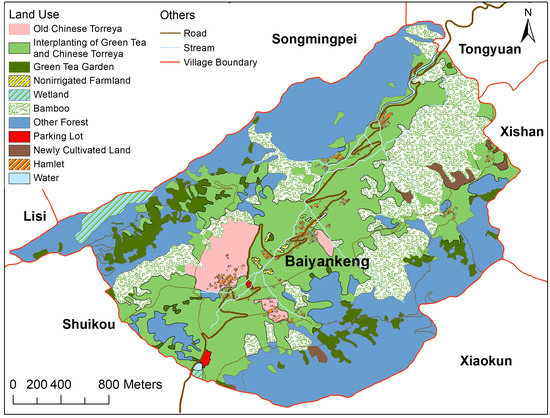
Figure 7.
Land use in Baiyankeng village in 2018 (hand-painted according to a remote sensing photo of 0.5 m/pixel taken on 20 April 2018, provided by the former Bureau of Surveying, Mapping and Geographic Information of Zhejiang Province).
Figure 8 shows the change in land use in the village between 2013 and 2019. The planting area of Chinese Torreya increased by 16.7% from 2013 to 2019, and the growth rate accelerated after 2017; the area of green tea plantations decreased by 5.2%, and the land for residential and other uses increased by 6.4%. Fundamental facilities such as roads and parking lots were constructed, so it was only natural that the size of residential land increased. In the meantime, parts of wild forests were reclaimed for the plantation of Chinese Torreya and green tea. Changes in other types of land were not obvious.
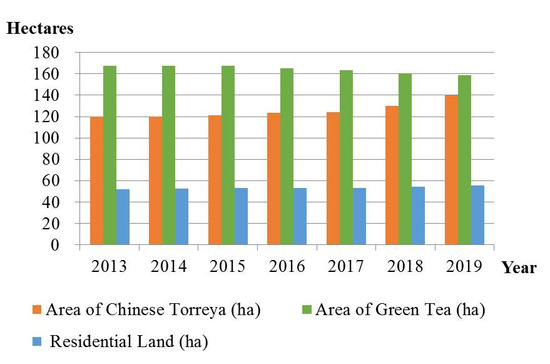
Figure 8.
Change in the areas of Chinese Torreya, green tea and living area in Baiyankeng village (2013–2019) (data provided by the village committee).
3.2.2. Changes in Population and Employment
Figure 9 shows the population and employment change from 2013 to 2019 in the village. Because of the household registration system in China, according to which an urban household registration cannot be changed to a rural one, there is no immigrant population in Baiyankeng village. As shown in Figure 9, although the registered population decreased slightly, the number of long-term residents rose from 482 to 608, accounting for an increase of 26.1%. The number of employed people in the village increased before 2016 and remained stable after 2016, with an increase of 61.0% from 2013 to 2019; the number of urban migrant workers declined before 2016 and remained stable after 2016, with a decrease of 50.2% from 2013 to 2019. The proportion of employed people in the village rose from 43.6% to 71.4%. Except for two village hydropower station managers, villagers were mainly engaged in agriculture, byproduct processing industries, and tourism services.
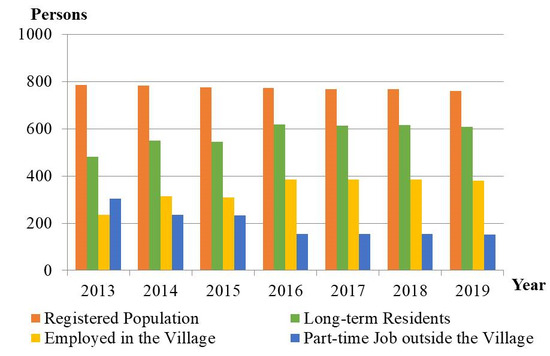
Figure 9.
The change in population and employment in Baiyankeng village (2013–2019) (data provided by the village committee).
As can be seen from Figure 9, although some of the villagers left the village for part-time jobs, others returned to grow Chinese Torreya or work service jobs in geotourism. It should be noted that the long-term resident population statistics include those who left the village for temporary or short-term part-time jobs. Of the long-term residents, half have spent the entirety of their lives in the village (mainly elderly and children), while the remaining half are seasonal residents who work in the village during busy farming seasons or tourism seasons. The data of the employed population in the village also include short-term urban migrant workers who shuttle back and forth seasonally between the village and cities.
3.2.3. Economic Change
Since the improvement work in the geocultural village, the industrial structure in the village has transformed and diversified the rural economy. Agriculture-oriented Baiyankeng village gradually started paying more attention to tourism. Figure 10 shows the revenue from tourism as well as the agricultural byproduct sales between 2013 and 2019. Agricultural byproduct sales revenue increased from 7.7 million yuan to 23 million yuan during this period, with an annual growth rate of 20.0%. We can thus infer that the rapidly developing tourism industry promoted the development of specific local agriculture and the rapid growth of agricultural byproduct sales. Figure 11 shows the farmers’ per capita disposable income between 2013 and 2019, with an annual growth rate of 30.2%, which began to slow in 2018. This rate was significantly higher than the average level of Zhejiang Province during the same time period. In 2019, the per capita disposable income of farmers in Baiyankeng village was 1.57 times the average of rural residents at the county level in Shengzhou City and 1.68 times the average of rural residents in the whole Zhejiang Province.
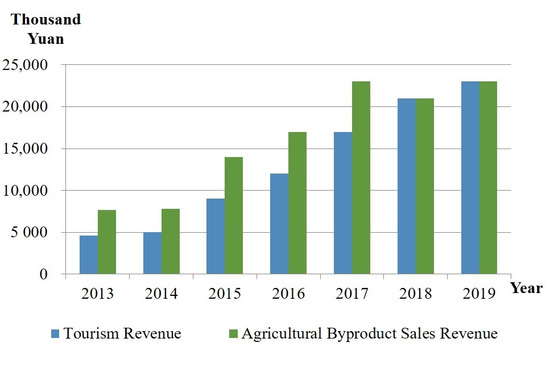
Figure 10.
Revenues of tourism and agricultural byproduct sales in Baiyankeng village (2013–2019) (data provided by the village committee).
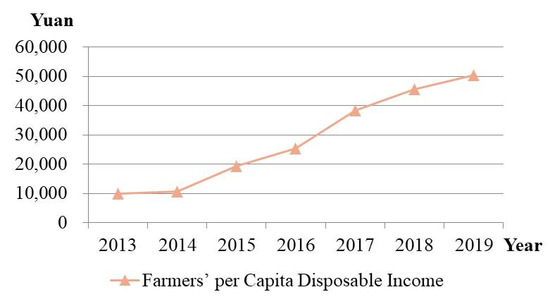
Figure 11.
Farmers’ per capita disposable income in Baiyankeng village (2013–2019) (data provided by the village committee).
3.3. Reasons for Changes in Land Use and Socioeconomic Situation
3.3.1. Geological and Cultivation Cultural Resources
Geological resources, the ecological environment, and traditional regional culture are the basis for the development of geocultural villages. Located in the high mountains, geological relics in Baiyankeng village, such as volcanic rock landforms, alpine wetlands, collapsed boulders, and other resources, have led to a culture of Chinese Torreya cultivation that attracts many tourists.
The geological aspects of the village make it suitable for the cultivation of Chinese Torreya trees [43,44]. Since green tea is commonly grown in Zhejiang Province, it does not realize as high a price as Chinese Torreya. Chinese Torreya products are also more popular among tourists than green tea products, which further drives up the sales and prices of Chinese Torreya nuts. Driven by economic interests, villagers are more willing to plant Chinese Torreya. By interplanting Chinese Torreya in green tea gardens (Figure 12), the Chinese Torreya trees continue growing year by year, while the area of green tea grown under the trees is shrinking.
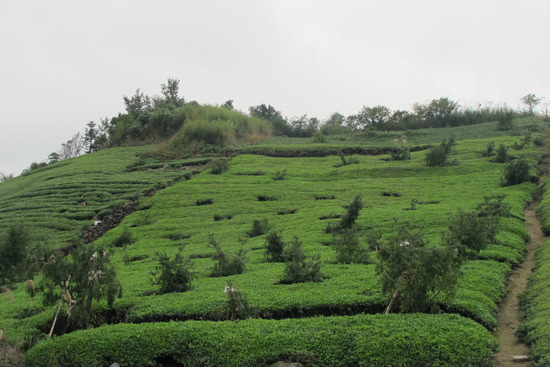
Figure 12.
The interplanting of green tea and Chinese Torreya in Baiyankeng village (photographed by Zhao in September 2019).
3.3.2. Increased Employment Opportunities and Greater Living Environment
Hose [19,20] stated that geotourism has the potential to extend the tourism season and enhance the local economy of participating areas by providing additional employment. In the case of Baiyankeng village, the increase in employment opportunities has become one of the main reasons for the decrease in migrant workers outside the village and the increase in long-term residents in the village. As mentioned above, the improvement work for Baiyankeng geocultural village has promoted the development of tourism. In addition to the rapid growth of the homestay guesthouse and catering industry, it has further promoted the production and sales of agricultural byproducts. The development of specific local agriculture and geotourism has promoted an increase in income and employment opportunities for the villagers. Therefore, more agricultural labor and service personnel are needed for the agricultural planting and curing of green tea and Chinese Torreya, the sale of agricultural byproducts, and homestay management services. The villagers are obtaining more and more opportunities to work in the village. Meanwhile, due to the improvement in rural sanitation, living conditions, and better medical and insurance coverage, more and more villagers who used to work part-time jobs in cities became willing to return to their hometowns to engage in these economic activities. From the interviews, it was understood that some of the villagers were even willing to work in the village for lower pay because the cost of living in the village is so much lower than in cities. There was no need to rent houses, and they could even grow vegetables and other types of food in the village for their own subsistence.
Besides long-term residents, the number of “seasonal villagers” is also increasing in this village. From the interviews, it is clear that agricultural production and tourism in Baiyankeng village are seasonal. The peak season for green tea production is April and May, the peak season for Chinese Torreya production is from September to October, and the peak season for tourism is from May to October. Employees can be engaged in both Chinese Torreya and green tea picking during the peak agricultural production and tourist season. Therefore, some villagers will still go out to work seasonally and only return to their hometown during the peak seasons of agriculture and tourism.
3.3.3. Formation and Upgrading of the Rural Industrial Structure
Baiyankeng village differs from the model of “departing farming without leaving native land” (pp. 63–68) in southern Jiangsu that was advocated by Fei in 1985 [8]. This concept refers to the phenomenon that the surplus rural labor force transfers from the agricultural sector to the nonagricultural sectors through employment in various local enterprises, especially after the Reform and Opening Up policies in China. Apart from agricultural byproduct processing, Baiyankeng village has no rural industry. A small hydropower station in the village is contracted to individuals, and there are only two daily village staff members, which can be called “departing farming without leaving native land.” Nonetheless, the villagers are making full use of the geological resources in the village and the GIAHS to change their lifestyle by reconstructing rural culture, developing geotourism, promoting homestay catering, improving agricultural byproduct processing and sales, and so on. Partly due to their status as a geocultural village, the tourism industry developed rapidly, and so did tourism income each year. The development of tourism has also promoted the simultaneous growth of agricultural production and sales of agricultural byproducts in Baiyankeng village. Simultaneously, the traditional agricultural technique of Chinese Torreya was successfully conserved.
3.3.4. Support of Local Government and the Influence of the Market
The Chinese governments can be divided into the national government, provincial government, prefectural-level city government, county government, and township government. The village committee is a self-governing organization. Further, the township government is closer to the village committee, so the development concepts and values of the township government are significant. As mentioned in Section 3.1.3, the Tongyuan Township Government and the Baiyankeng Village Committee aggressively pitched for Baiyankeng to be the first geocultural village. The township government connects the county/provincial government and the village committee, and they actively push the improvement work and the promotion of the geocultural village by supporting the infrastructure and public facilities with raised funds and new technology.
Moreover, the national-level rural vitalization policies of China have promoted the development of geocultural villages from a macro perspective. As a developing country, the rapid economic development of China and improvement in living standards have expedited the phenomena of “urban disease” and triggered urban residents’ yearning for rural leisure tourism to interact with nature and geoscience, which is very promising for the future development of geocultural villages.
4. Discussion
This section clarifies the endogenous mechanism of a geocultural village and analyzes its endogeneity. The endogeneity of this village is analyzed from the perspective of China’s land systems and people’s actions compared to geoparks in China and the LEADER program of the European Union (EU).
4.1. Endogenous Mechanism of a Geocultural Village
Under the guidance of the township government and the village committee, Baiyankeng village integrated the geological resources, land resources, ecological environment, funds, and labor to become a successful geocultural village pioneer. Besides promoting geotourism, they also drove characteristic agriculture and the development of other related rural industries. Rapid socioeconomic development followed, and an endogenous rural development model based on the conservation and utilization of geological resources was formed in the village. Scheme 1 shows the endogenous development mechanism of Baiyankeng village in this study.
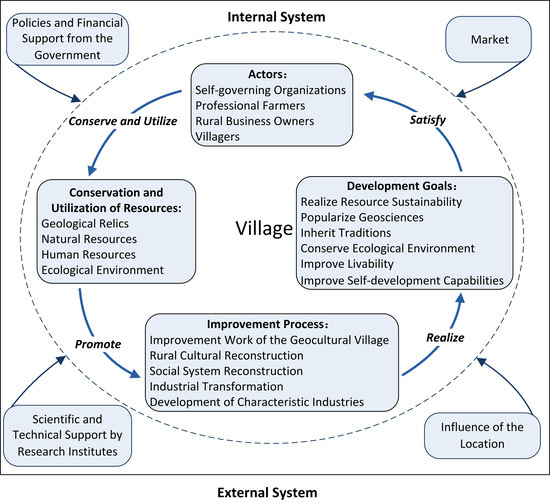
Scheme 1.
The endogenous development mechanism of Baiyankeng geocultural village.
The Baiyankeng geocultural village’s endogenous development mechanism model can be divided into internal and external systems. The internal system is the core of endogenous development in Baiyankeng village, while the external system has a significant impact on rural vitalization. The internal system is composed of actors, the conservation and utilization of resources, the improvement process, and development goals. This recycling mechanism in Scheme 1 starts from the conservation and utilization of geological resources by self-governing organizations (the village committee) that consist of professional farmers, rural business owners, and villagers as actors. Through the conservation and utilization of the resources, the traditional culture and industrial structure of the village were rebuilt. In the case of Baiyankeng village, the tourism, green tea, and Chinese Torreya industry developed synergistically in tandem. The overall quality of life and self-development capabilities were developed without jeopardizing the ecological environment, which helped achieve the goals of rural vitalization and sustainable development. The external system includes policies and financial support from the government, the guidance of research institutes, location advantages, and market influence. As mentioned in Section 1.1, Tsurumi [14] emphasized social interactions with outsiders (pp. 23–29), while Miyamoto [18] emphasized government subsidies in endogenous development (pp. 295–298). Both their arguments on the nature of outside influences can be seen in the mechanism of Scheme 1, which shows that the internal system of the village aims to develop sustainably while continuously benefiting from the external system.
Although over a hundred villages in Zhejiang Province are slated to become geocultural villages, it is still a new policy that has been implemented for less than 10 years, which means that facilitation and implementation have only been conducted within a few villages. Since every village has its own local characteristics, Scheme 1 may not be generalizable to every geocultural village in the future. However, since Baiyankeng village is the pilot and representative one, into which actors have put maximum effort, the mechanism identified in this study might have policy implications for later ones.
4.2. Endogeneity from the Perspective of the Land System of China
After the policy of geocultural villages was launched in Zhejiang Province in 2013, the conservation system of geological resources in China can be seen in Scheme 2, which differs from geoparks. The geoparks in China are divided into UNESCO global geoparks, national geoparks, and provincial geoparks. Geocultural villages can encourage geoconservation in those areas that cannot be registered as geoparks. Both geoparks and geocultural villages simultaneously pursue geoconservation and development.

Scheme 2.
The conservation system of geological resources in China.
As shown in Scheme 1, the schematic center of the endogenous mechanism of geocultural villages is the “village,” which directly leads to the main differences between geoparks and geocultural villages. A geocultural village is different because the boundary is delineated inside the scale of an administrative village or a natural village. Nonetheless, the roots of the geocultural village can be seen in geoparks despite their many differences.
The differences between geoparks and geocultural villages are listed in Table 4. Compared with the former national and provincial geopark guidelines of China [45,46], the differences between geoparks and geocultural villages in China lie mainly in the aspects of spatial range, criteria of improvement work, management, and objectives. As mentioned above, the Land Law of China determines the top-down management system of geoparks in China and differentiates them from geoparks in other countries. Since the spatial range of a geocultural village is a village, which is smaller than a geopark in China, the subject of administration between geocultural villages and geoparks is different. Compared to most geoparks in China operated by the government, the geocultural village prioritizes self-governance by the villagers. In the case of geoparks in China, land use is controlled strictly by the government, and the government will sometimes compensate local rural residents for moving away from the core geopark conservation areas. In contrast, there is no such moving and compensation for geocultural villages. Since the land of the village is collectively owned by the local registered villages, the self-governing village committee plays a bigger role in the management and development of the geocultural village. The lack of local participation in geoparks in China [26,28] has been solved to some extent by geocultural villages because bottom-up management can be realized within the scale of an administrative village. This perspective of people’s actions will be elaborated on in Section 4.3.

Table 4.
The differences between geoparks and geocultural villages in China.
Regarding the objectives of development, although both geoparks and geocultural villages aim to develop the local economy in developing regions, geocultural villages are recognized as a new idea that closely aligns with the strategy of rural vitalization. The promotion of geotourism in a village facilitates the development of characteristic agriculture. In the case of Baiyankeng village, Chinese Torreya and green tea and their byproduct processing industries have been formed. By integrating primary, secondary, and tertiary industries, geotourism creates new ways for people in mountainous areas to increase their incomes, which ultimately results in rural vitalization and sustainable development. Considering the restriction of land rights in China, geocultural villages can be considered as open rural geoparks in China.
4.3. Endogeneity from the Perspective of People’s Actions
As mentioned in Section 4.2, in the conservation system of geocultural villages, the self-governing village committee plays a big role in the management and development of geocultural villages. Therefore, it is important to note that the support of policies and funding from the government falls under the external system. Instead, self-governing organizations that consist of professional farmers, rural business owners, and villagers as the main actors are the key drivers of development in the village. The government leads the primary period of improvement work of geocultural villages and prevents cropland from being destroyed, which is the advantage of the top-down administration in China. However, the top-down administration ignores the variety and characteristics of different regions and did not solve the root problem. Like the target area in this study, Baiyankeng village of Zhejiang Province, which has little cropland, is more suitable for growing cash crops rather than grain crops. In this study, the village committee, which played a key role in the establishment, expressed high aggressiveness toward the government’s idea of geocultural villages.
The relationship of actors in the improvement work of geocultural villages is shown in Scheme 3. In this study, the township government can be called a promoter, while the village committee plays the role of a leader, an organizer, and professional farmers, rural business owners, and villagers play the role of implementers. In China, rural areas implement the administrative system of “township government and village governance” comprising two parts: “township government” and “village governance.” The grassroots government is established in townships, and the state administration functions are exercised; however, this government does not directly manage grassroots social affairs. Instead, villages below the township establish villagers’ self-government organizations—the village committees—to exercise autonomy over the management of village affairs. In this system of “township government and village governance,” there is a top-down administration of the township government along with villagers’ autonomy. Under the administrative system of “township government and village governance,” although the township government belongs to the government, it links the higher-level government and the village. Compared with the provincial government, the township government knows more about the local conditions of the villages and has close communication with the villages, so they can provide suggestions for the improvement work of the geocultural village, directly raise funds and strive for policies from the upper governments, and can also give advice and guidance to the villages. Close cooperation is formed between the township government, village committees, and villagers. Moreover, the improvement in villagers’ cognition of geocultural villages and their awareness of participation is a determining factor for rural development.
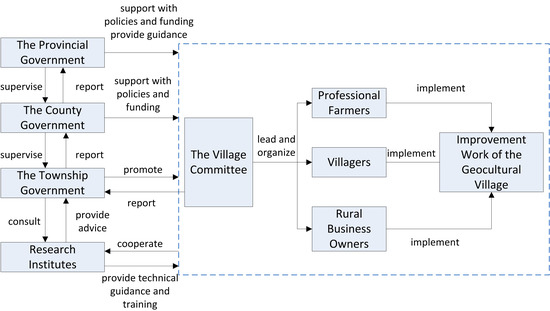
Scheme 3.
Relationship between actors in a geocultural village.
The endogenous development of geocultural villages in China shares some similar characteristics with the EU’s LEADER program, especially in the aspect of public funds and local action groups (LAGs). The term “LEADER” originally came from the French acronym for “liaison entre actions de développement de l’économie rurale,” which means “links between the rural economy and development actions” [47]. LEADER is a local rural development policy that takes a “bottom-up” or “participatory” approach with a smaller territory [48], with the aim of mobilizing and delivering rural development in local rural communities, rather than a fixed set of measures to be implemented, indicating a focus on “how” to proceed rather than “what” needs to be done [49]. Public–private partnerships play an important role in local action. Global grants, cofinanced by the EU and national public funds, are the most common form of financing for LEADER projects and actions [49], while the government is the main financial support for the geocultural villages in China. The LAGs in the LEADER program contain people from different associations, such as local communities, organizations, administrations, and external networks [49]. Geocultural villages also have actors similar to LAGs. The “LAGs” in a geocultural village can be considered both the township government and village committee, as they have close relationships (Scheme 3), decision-making autonomy, and the capacity to re-evaluate local resources.
However, the management of the LEADER programs is quite flat, with only three levels: a European network for rural development (run by the commission), a national rural network to be set up in each member state, and the network of LAGs. In contrast, since the “LAGs” of geocultural villages in China are far from national authorities, it is more difficult to manage LAGs at the national administration level in China. Therefore, in the case of China, the cognition and values of the township government and village committee have enormous implications for local rural development. Tu et al. [50] argued that the credibility and cohesion of the township government and village committee are important factors in stimulating the value orientation of ordinary farmers to build their own hometowns together. Therefore, in this empirical research into Baiyankeng village, the LAGs’ conception of development, as well as the willingness to establish the geocultural village, will directly affect the sustainable development of the village.
Furthermore, LAGs in the EU can decide “how” to proceed, while the township government and the village committee only promote and organize “what” needs to be done. Nowadays, the rural community and villagers’ participation can only be seen in the process of the improvement work rather than in the decision-making process, which is a limitation to the endogeneity of development at the present stage. The government’s management role in rural development is yet to completely change from “intervention” to “guidance,” and they need to adequately consider the potential of rural self-development capabilities as well.
Burek et al. [22] argued that the significance of geoconservation is concentrated on “the actions taken,” which also include promotional and awareness-raising activities. However, the villagers are motivated to act by the economic profits through the sale of Chinese Torreya nuts, the homestay guesthouses, and caterers. Ironically, the villagers should take part in the improvement work of geocultural villages only to completely undermine the original goals. For example, some wild forests have been destroyed by the cultivation of fields for Chinese Torreya in Baiyankeng village. Nonetheless, during the fieldwork, it is obvious that some of the villagers started to worry about the environmental pollution and overcultivation of Chinese Torreya trees brought by large numbers of tourists. In the case of this study, the villagers are rather positive toward the geocultural village, which encourages them to protect the village themselves. In other words, since awareness raising occurs during local activities, self-development capabilities should improve concurrently. This will enable the achievement of sustainable development in the long term.
5. Conclusions
The geocultural village is a development model based on the conservation and utilization of geological resources and the reconstruction of local culture to promote rural vitalization. This study clarified the endogenous development mechanism of geocultural villages by exploring land use change, industrial transformation, and their impacts on rural society and economy after Baiyankeng village was registered as the pilot geocultural village in China. In the case of Baiyankeng village, Chinese Torreya cultivation was enabled by its geological resources, which, in turn, anchored the endogenous development mechanism. The village committees, with professional farmers, rural business owners, and villagers as the main actors, participated actively in this rural vitalization project. As a result, the tourism, green tea, and Chinese Torreya industries developed synergistically and rapidly. To summarize, the geocultural village policy has led to a positive impact on land use suitability, a resolution of the three-dimensional rural issues, and improved social and economic development. It played a significant role in promoting geotourism, characteristic agriculture, and the formation of new industries. It also improved the living standards and enriched the scientific knowledge of residents while gradually reversing the current decline in the rural population.
The Baiyankeng geocultural village’s endogenous development mechanism model can be divided into internal and external systems. The internal system is composed of actors, the conservation and utilization of resources, improvement processes, and development goals. The external system includes policies and financial support from the government, the guidance of research institutes, location advantages, and market influence. The internal systems can help achieve sustainable development goals while benefiting from the external system.
The endogeneity of this village was analyzed from the perspective of China’s land systems compared to geoparks in China. Geocultural villages can be considered a kind of geopark in China aimed at rural vitalization; thus, a rural geopark. The concept of geocultural villages originated from the concept of geoparks, but the different ownership of land differentiates them from geoparks in the aspects of spatial range, criteria of improvement work, management, and objectives. Taking the village area as a unit, the geocultural village aims to realize “bottom-up” management and self-governance by the villagers themselves and to conserve distinct local characteristics.
This study shows that the township government is an internal factor in the endogenous development of villages, which is different from the endogenous mechanism in the rural areas of other countries. Against the backdrop of the “township government and village governance” management system in China and the collective ownership of land in the rural areas of China, township governments that can deeply understand the local situations and share a close relationship with the villages play a significant role in the facilitation and implementation of geocultural villages. As a result, the township government can be regarded as a promoter, while the village committee takes the role of a leader and organizer, and professional farmers and rural business owner and villagers serve as implementers.
The endogeneity of this village was also analyzed from the perspective of people’s actions compared to the LEADER program of the EU. Geocultural villages share some similar points with the EU’s LEADER program from the aspects of public funds, local action groups, and public–private partnerships. Nonetheless, there are some notable differences between geocultural villages and the LEADER program. Since geocultural villages are implemented in a smaller area within the scale of a village, the management is more complex compared to the LEADER program. Therefore, the cognition and values of LAGs, such as the township government and village committee, have greater implications for geocultural village policy. Although the government’s management role in rural development has not completely changed from “intervention” to “guidance,” which seems to be a limitation of endogenous development of this study, self-development capabilities can be improved through the direct participation of villagers and generate potential endogeneity.
Since geocultural village policy has been limited for only a short time, the accumulation of case villages and data is limited. In addition, the COVID-19 pandemic has impacted tourism since 2020. Therefore, the results of this study only reflect the stage and characteristics of geocultural village development in Baiyankeng village before the pandemic, suggesting the need to follow up and study new trends. Overdevelopment prevention, volunteer tour guides, self-development capabilities, decision-making mechanism of actors, benefit-sharing mechanisms, and smart communities will be the focuses of future research.
Author Contributions
Conceptualization, W.Z.; data curation, W.Z.; formal analysis, W.Z.; funding acquisition, W.Z.; investigation, W.Z.; methodology, W.Z.; project administration, W.Z.; resources, W.Z.; software, W.Z.; supervision, T.M.; validation, W.Z.; visualization, W.Z.; writing—original draft, W.Z.; writing—review and editing, W.Z. and T.M. All authors have read and agreed to the published version of the manuscript.
Funding
This work was supported by JST SPRING, grant number JPMJSP2124.
Institutional Review Board Statement
Not applicable.
Informed Consent Statement
Informed consent was obtained from all participants involved in the study.
Data Availability Statement
Not applicable.
Acknowledgments
The authors are grateful to the Department of Natural Resources of Zhejiang Province, Zhejiang Geological Archives, the Natural Resources and Planning Bureau of Shengzhou City, the former Tongyuan Township Government, and the former Bureau of Surveying, Mapping, and Geographic Information of Zhejiang Province for providing the data for this study. We would also like to thank the village committee of Baiyankeng and all the villagers who assisted in data collection.
Conflicts of Interest
The authors declare no conflict of interest.
Notes
| 1 | Torreya grandis is a type of tertiary relict plant originating in China. It is a unique plant and a secondary-level key protected wild plant of China, widely distributed in broad-leaved mixed forest zones in eastern and central China. Chinese Torreya (Torreya grandis cv. Merrillii) is a type of quality grafting plant resulting from artificial selection. Its main properties and economic values are different from other types of Torreya grandis and it is a valuable plant that can be used for nuts, medicine, logs, oil, ornaments, and environmental protection purposes [36]. Torreya grandis in this research refers to Torreya grandis cv. Merrillii and uses the term “Chinese Torreya” or “Torreya” for short. |
| 2 | The Household Contract Responsibility System with Remuneration Linked to Output, which is also simply translated as the Household Responsibility System, is an essential component of the agricultural reform initiated by China in the late 1970s. Under the system, land or certain tasks are contracted to individual households for a period of time. After fulfilling the procurement quota obligations to the state, farmers are free to keep their surplus for their use or sell it on the market [38]. |
References
- Wen, T. Two Basic Contradictions Faced by the Second Step of Rural Reform. Strategy Manag. 1996, 3, 111–114. Available online: https://kns.cnki.net/kcms/detail/detail.aspx?dbcode=CJFD&dbname=CJFD9697&filename=ZYGL603.018&uniplatform=NZKPT&v=ECt1RzP_e_Y-HeYIQS7LyrCLxCiBRrtHgh29kiEcHPeG8cnyYKvYPq_Smpw3_jA4 (accessed on 3 April 2022). (In Chinese).
- Wen, T. Two Basic Contradictions Constraining the Agriculture-Countryside-Farmer Problem. Rev. Econ. Res. 1996, D5, 17–23. (In Chinese) [Google Scholar] [CrossRef]
- Lu, X. The Origin and Development of the Agriculture-Countryside-Farmer Problem in China. Contemp. China Hist. Stud. 2004, 3, 4–15. Available online: https://kns.cnki.net/kcms/detail/detail.aspx?dbcode=CJFD&dbname=CJFD2004&filename=DZSY200403001&uniplatform=NZKPT&v=eTfoB9jxgojfIPcJPa35ip1svgVjICNRkLYD98G4px_BU8yEu0IP8ohc4LNUqnwk (accessed on 3 April 2022). (In Chinese).
- Ye, J. The Issues Relating to Agriculture, Rural Areas and Rural People: An Exaggerated Academic Concept and Its Limitations. Southeast Acad. Res. 2018, 5, 112–123. (In Chinese) [Google Scholar] [CrossRef]
- Fei, X. From the Soil; Joint Publishing: Shanghai, China, 1948. (In Chinese) [Google Scholar]
- Fei, X. Rural Recovery; Shanghai Observation Company: Shanghai, China, 1948. (In Chinese) [Google Scholar]
- Fei, X. Economics of Jiangcun: The Life of Chinese Farmers; Jiangsu People’s Publishing House: Nanjing, China, 1986. (In Chinese) [Google Scholar]
- Fei, X. Four Notes on Small Towns; Xinhua Publishing House: Beijing, China, 1985; pp. 51–74. (In Chinese) [Google Scholar]
- Lai, Y. Adhere to the Rural Modernization Road of Endogenous Development—A Research on Rural Social Development in the New Era Under the Guidance of the Scientific Development Concept. Study Pract. 2009, 11, 113–125. (In Chinese) [Google Scholar] [CrossRef]
- Long, H.; Zhang, Y.; Tu, S. Land Consolidation and Rural Vitalization. Acta Geogr. Sin. 2018, 73, 1837–1849. Available online: https://kns.cnki.net/kcms/detail/detail.aspx?dbcode=CJFD&dbname=CJFDLAST2018&filename=DLXB201810003&uniplatform=NZKPT&v=q7aVoMflzBEzZJiU56GB6ImbpGi9snxWNPcGy9pVPCnFiLAdgd0lT2RnZuPB8LQT (accessed on 3 July 2021). (In Chinese).
- The Dag Hammarskjöld Foundation. What Now? Another Development. Prepared on the Occasion of the 7th Special Session of the United Nations General Assembly, NY, USA, 1–12 September 1975. Available online: https://www.daghammarskjold.se/publication/now-1975-dag-hammarskjold-report/ (accessed on 9 May 2022).
- Tsurumi, K. Chapter 2–Genealogy of Endogenous Development Theory. In Endogenous Development Theory; Tsurumi, K., Kawata, T., Eds.; University of Tokyo Press: Tokyo, Japan, 1989; pp. 43–64. ISBN 4-13-050100-3. (In Japanese) [Google Scholar]
- The Dag Hammarskjöld Foundation. Another Development and the Third System. Development Dialogue. 1985, 23, 1–188. Available online: https://www.daghammarskjold.se/publication/another-development-third-system/ (accessed on 9 May 2022).
- Tsurumi, K. The Development History of Endogenous Development Theory; Chikuma Shobo: Tokyo, Japan, 1996; pp. 23–39, 67–87. ISBN 4-480-85732-X C1036. (In Japanese) [Google Scholar]
- Hobo, T. Endogenous Development Theory and Japanese Rural Villages; Iwanami Shoten: Tokyo, Japan, 1996; pp. 122–125. ISBN 4-00-001544-3. (In Japanese) [Google Scholar]
- Matsumiya, A. Some Problems on the Concept of “Endogenous Development”: An Essay on the Development of Endogenous Development. Soc. Welf. Stud. 2001, 3, 45–54. (In Japanese) [Google Scholar] [CrossRef]
- Takayanagi, N. Endogenous Development of Rural Areas by Sixth Industrialization. In Understanding Japanese Rural Villages: Takeo Ichikawa and Contemporary Geography; Inui, T., Ed.; Kokon Shoin: Tokyo, Japan, 2020; pp. 175–192. ISBN 978-4-7722-6118-0. (In Japanese) [Google Scholar]
- Miyamoto, K. Environmental Economics; Iwanami Shoten: Tokyo, Japan, 1989; Chapter 5; pp. 273–348. ISBN 4-00-000326-7. (In Japanese) [Google Scholar]
- Hose, T.A. Chapter 2–Geotourism: Appreciating the Deep Time of Landscapes. In Niche Tourism: Contemporary Issues, Trends and Cases; Novelli, M., Ed.; Oxford University Press: Oxford, UK, 2005. [Google Scholar] [CrossRef]
- Hose, T.A. The English Origins of Geotourism (as a Vehicle for Geoconservation) and Their Relevance to Current Studies. Acta Geogr. Slov. 2011, 51, 343–359. [Google Scholar] [CrossRef]
- Hose, T.A. Selling the Story of Britain’s Stone. Environ. Interpret. 1995, 10, 16–17. [Google Scholar]
- Burek, C.V.; Prosser, C.D. The History of Geoconservation: An Introduction. Geol. Soc. Lond. Spec. Publ. 2008, 300, 1–5. [Google Scholar] [CrossRef]
- Webber, M.; Christie, M.; Glasser, N. The Social and Economic Value of the UK’s Geodiversity. In English Nature Research Reports; English Nature: Peterborough, UK, 2006; Volume 709, pp. 1–113. Available online: http://publications.naturalengland.org.uk/file/72001 (accessed on 7 July 2022).
- UNESCO Global Geoparks. Available online: https://en.unesco.org/global-geoparks (accessed on 11 January 2022).
- Dong, H.; Song, Y.; Chen, T.; Zhao, J.; Yu, L. Geoconservation and Geotourism in Luochuan Loess National Geopark, China. Quat. Int. 2014, 334–335, 40–51. [Google Scholar] [CrossRef]
- Fukami, S. Geotourism and Ecotourism; Kokon Shoin: Tokyo, Japan, 2014; pp. 71–90. ISBN 978-4-7722-4179-3. (In Japanese) [Google Scholar]
- Han, J.; Wu, F.; Tian, M.; Li, W. From Geopark to Sustainable Development: Heritage Conservation and Geotourism Promotion in the Huangshan UNESCO Global Geopark (China). Geoheritage 2018, 10, 79–91. [Google Scholar] [CrossRef]
- Wang, L.; Tian, M.; Wen, X.; Zhao, L.; Song, J.; Sun, M.; Wang, H.; Lan, Y.; Sun, M. Geoconservation and geotourism in Arxan-Chaihe Volcano Area, Inner Mongolia, China. Quat. Int. 2014, 349, 384–391. [Google Scholar] [CrossRef]
- Fukami, S. Perspective on Geoparks and Geotourism Basedon Case Studies of Geoparks in Japan and China. Jpn. J. Hum. Geogr. 2013, 65, 58–70. (In Japanese) [Google Scholar] [CrossRef][Green Version]
- The Law of Land Administration of the People’s Republic of China. 2019. Available online: http://www.npc.gov.cn/npc/c30834/201909/d1e6c1a1eec345eba23796c6e8473347.shtml (accessed on 3 August 2021). (In Chinese)
- Han, C. Rural Land System Reform of China. Available online: http://www.moa.gov.cn/ztzl/xczx/rsgt/201812/t20181228_6165784.htm (accessed on 1 May 2022). (In Chinese)
- Chang, L.; Watanabe, T. The Mutual Relationship between Protected Areas and Their Local Residents: The Case of Qinling Zhongnanshan UNESCO Global Geopark, China. Environments 2019, 6, 49. [Google Scholar] [CrossRef]
- China Geological Survey; Geological Society of China. Guidelines for the Establishment of Geological Cultural Villages (Towns). 2020. Available online: http://www.cgs.gov.cn/tzgg/tzgg/202005/t20200509_636506.html (accessed on 9 June 2020). (In Chinese)
- The People’s Government of Shengzhou City. Shengzhou Statistical Yearbook 2012–2020. Available online: http://www.szzj.gov.cn/col/col1529965/index.html (accessed on 12 November 2021). (In Chinese)
- Zheng, J.; Liu, Y. The Investigation of Geological Environment Resources and the Evaluation Report of the Geocultural Village in Tongyuan Township, Shengzhou City; Zhejiang Geological Archives: Shengzhou, China, 2015. (In Chinese) [Google Scholar]
- GIAHS Homepage. GIAHS Proposal: Kuaijishan Ancient Chinese Torreya Community. Available online: https://www.fao.org/giahs/giahsaroundtheworld/designated-sites/asia-and-the-pacific/kuajishan-ancient-chinese-torreya/annexes/en/ (accessed on 26 July 2022).
- GIAHS homepage. Kuaijishan Ancient Chinese Torreya, China. Available online: https://www.fao.org/giahs/giahsaroundtheworld/designated-sites/asia-and-the-pacific/kuajishan-ancient-chinese-torreya/en/ (accessed on 12 November 2019).
- Cheng, L. Household Responsibility System. In Berkshire Encyclopedia of China, 1st ed.; Berkshire Publishing Group: Great Barrington, MA, USA, 2009; pp. 1066–1072. ISBN 978-0977015948. [Google Scholar]
- Qian, Z.; Qian, Q.; Si, B. The Chronicle of Baiyankeng Village; Baiyankeng Village Committee: Shengzhou, China, 2016. (In Chinese) [Google Scholar]
- Ni, Q.; Jin, X. The Establishment Plan of the Geoculture Village in Tongyuan Township, Shengzhou City; Provided by Zhejiang Geological Archives; Hangzhou Aiqinhai Landscape Design Co., Ltd.: Hangzhou, China, 2016. (In Chinese) [Google Scholar]
- The Tongyuan Township Government of Shengzhou City. Tongyuan Township Geocultural Characteristic Village Establishment Summary Report; Provided by the Tongyuan Township Government: Shengzhou, China, 2018; (In Chinese).
- The Department of Natural Resources of Zhejiang Province. World Earth Day Activities Enter the Countryside of Zhejiang: Geoculture Village, With a Beautiful Future. 24 April 2019. Available online: http://zrzyt.zj.gov.cn/art/2019/4/24/art_1292569_33713755.html (accessed on 12 November 2019). (In Chinese)
- Wang, X.; Wang, K.; Qin, S.; Jiang, Y. A Review of Research on Favorable Environmental Factors of Torreya grandis “Merrillii”. J. Zhejiang For. Coll. 2008, 25, 382–386. Available online: https://kns.cnki.net/kcms/detail/detail.aspx?dbcode=CJFD&dbname=CJFD2008&filename=ZJLX200803028&uniplatform=NZKPT&v=p5pRd7yfq5s9xqiL9jG-gkyn6tvj3sPzb0GCvVPIjD5OHl9Z8lJEy5m3Xrb9nGQj (accessed on 1 August 2021). (In Chinese).
- Guo, Y. Ecological Service Functions of Ancient Chinese Torreya Forests and Their Economic Value Assessment in Shengzhou, Zhejiang. Contemp. Econ. 2019, 2, 101–105. Available online: https://kns.cnki.net/kcms/detail/detail.aspx?dbcode=CJFD&dbname=CJFDLAST2019&filename=DAJJ201902034&uniplatform=NZKPT&v=hQ-zqWfWNbiTdQkwM0CK7m493jPOMK_rL3cylz1kYBSK-hM0D2jFUdXtfghV9sRi (accessed on 30 January 2021). (In Chinese).
- The Department of Geological Environment, the Ministry of Land and Resources, P.R.C. Chinese National Geoparks Building Guide; Geology Press: Beijing, China, 2016; ISBN 978-7-116-08260-1. (In Chinese) [Google Scholar]
- The Department of Land and Resources of Zhejiang Province. Zhejiang Provincial Geoparks Establishment Standards (Trial); Department of Natural Resources of Zhejiang Province: Hangzhou, China, 2016; (In Chinese).
- European Network for Rural Development. LEADER/CLLD. Available online: https://enrd.ec.europa.eu/leader-clld_en#_edn1 (accessed on 8 July 2022).
- Ray, C. Towards a Theory of the Dialectic of Local Rural Development within the European Union. Sociol. Rural. 1997, 37, 345–362. [Google Scholar] [CrossRef]
- European Commission. The LEADER Approach: A Basic Guide; Office for Official Publication of the European Communities: Luxembourg, 2006; Available online: https://enrd.ec.europa.eu/publications/leader-approach-basic-guide_en (accessed on 8 July 2022).
- Tu, S.; Long, H.; Zhang, Y.; Zhou, X. Process and Driving Factors of Rural Restructuring in Typical Villages. Acta Geogr. Sin. 2019, 74, 323–339. Available online: https://kns.cnki.net/kcms/detail/detail.aspx?dbcode=CJFD&dbname=CJFDLAST2019&filename=DLXB201902010&uniplatform=NZKPT&v=0AefslCxAQE2Ebwx8an6-5EtbjUuUoKSOo_iAq61-RZ4OZHqMgwmPcwDxVSk4Wf (accessed on 21 February 2021). (In Chinese).
Publisher’s Note: MDPI stays neutral with regard to jurisdictional claims in published maps and institutional affiliations. |
© 2022 by the authors. Licensee MDPI, Basel, Switzerland. This article is an open access article distributed under the terms and conditions of the Creative Commons Attribution (CC BY) license (https://creativecommons.org/licenses/by/4.0/).